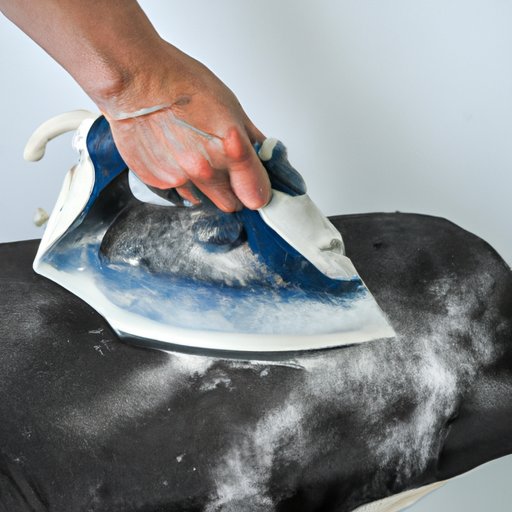
I. Introduction
Ironing is an important chore that helps us maintain a professional appearance and crisp, clean clothes. However, it’s crucial to keep our irons clean so they don’t damage our clothes or lose efficiency. In this article, we’ve put together a complete guide on how to clean your iron, including step-by-step instructions and alternative methods to use.
II. Step-by-Step Guide on Cleaning an Iron Using Vinegar and Baking Soda
One of the most popular ways to clean your iron is by using vinegar and baking soda. Here’s what you’ll need:
- White vinegar
- Baking soda
- Water
- A soft cloth
Instructions:
- Mix a 1:1 ratio of white vinegar and water and pour it into the water tank of the iron.
- Turn the iron on to the highest steam setting and let it heat up.
- Place a small amount of baking soda onto the soft cloth and scrub the iron’s surface.
- Empty the vinegar and water mixture from the water tank and refill it with clean water. Turn on the iron and allow it to heat up, then empty the tank again.
Tip: To remove stubborn stains, dip the cloth into the vinegar and baking soda mixture and scrub the surface of the iron.
III. Best Cleaning Solutions and Materials for Iron Plates
If you’re looking for alternative cleaning solutions and materials to use, salt and lemon or hydrogen peroxide are both great options. Here’s how to use them:
- Salt and Lemon: Cut a lemon in half and sprinkle salt onto the cut side. Rub the lemon half over the surface of the iron.
- Hydrogen Peroxide: Dip a cotton ball into hydrogen peroxide and spread it over the surface of the iron. Let it sit for a few minutes before wiping it off with a clean cloth.
IV. Tips for Maintaining the Cleanliness of Your Iron
It’s important to maintain the cleanliness of your iron in order to maximize its efficiency and lifespan. Here are some tips for maintaining your iron’s cleanliness:
- Wipe down the iron after each use with a damp cloth.
- Avoid overfilling the water tank to prevent mineral build-up.
- Store the iron in an upright position to prevent water from leaking onto the surface.
V. Common Mistakes When Cleaning an Iron
While cleaning your iron, it’s important to avoid these common mistakes which can damage your iron:
- Using abrasive materials like steel wool or sandpaper to scrub the surface of the iron.
- Using harsh chemicals like bleach or ammonia which can cause damage to the iron’s surface.
- Using too much water, which can result in mineral build-up in the water tank.
VI. Alternative Methods of Cleaning Your Iron
If you’re not interested in using vinegar and baking soda or other natural solutions, there are also commercial iron cleaners or homemade cleaning solutions made with dish soap and water. Here are the pros and cons:
- Commercial Iron Cleaners: Pros – Easily accessible and effective. Cons – Can be expensive and contain harsh chemicals.
- Homemade Cleaning Solutions: Pros – Easy to make and use. Cons – May not be as effective as commercial cleaners.
VII. Traditional vs Eco-Friendly Methods for Cleaning an Iron
When it comes to cleaning your iron, you can use traditional or eco-friendly methods. Here are the pros and cons of each:
- Traditional Methods: Pros – Proven to be effective. Cons – Often use harsh chemicals.
- Eco-Friendly Methods: Pros – Use natural ingredients and are environmentally friendly. Cons – May not be as effective as traditional methods.
VIII. Importance of Cleaning Your Iron for Lifespan and Efficiency
Regular cleaning of your iron can save you money in the long run by increasing its lifespan and efficiency. When an iron is clean, it will glide smoothly over fabrics and produce a consistent amount of heat, resulting in better performance.
IX. Conclusion
Cleaning your iron is essential for ensuring it operates effectively and lasts as long as possible. Remember to avoid common cleaning mistakes and to use alternative methods if needed. By maintaining your iron’s cleanliness, you’ll save money and time in the long run, while also ensuring your clothes look their best every day.





